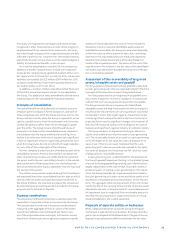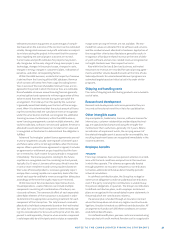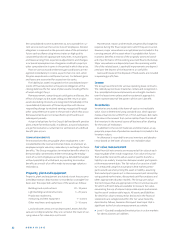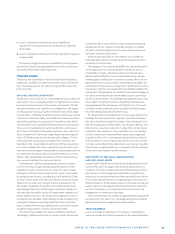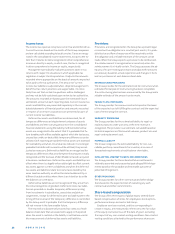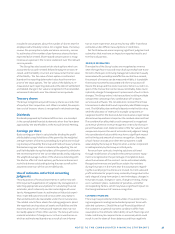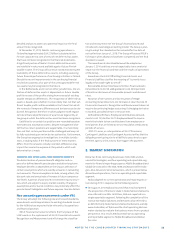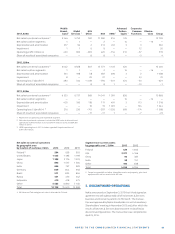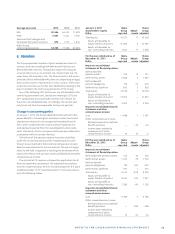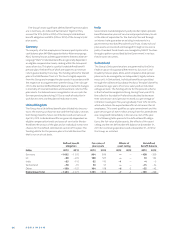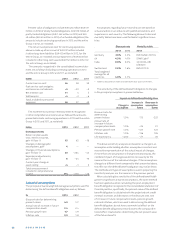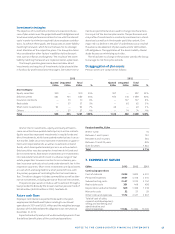Nokia 2013 Annual Report Download - page 39
Download and view the complete annual report
Please find page 39 of the 2013 Nokia annual report below. You can navigate through the pages in the report by either clicking on the pages listed below, or by using the keyword search tool below to find specific information within the annual report.37
NOTES TO THE CONSOLIDATED FINANCIAL STATEMENTS
included in assumptions about the number of shares that the
employee will ultimately receive. On a regular basis, the Group
reviews the assumptions made and where necessary, revises
its estimates of the number of performance shares that are
expected to be settled. Share-based compensation is recog-
nized as an expense in the income statement over the relevant
service periods.
The Group has also issued certain stock options which are
accounted for as cash-settled. Related employee services re-
ceived, and the liability incurred, are measured at the fair value
of the liability. The fair value of stock options is estimated
based on the reporting date market value less the exercise
price of the stock options. The fair value of the liability is re-
measured at each reporting date and at the date of settlement
and related change in fair value is recognized in the consolidat-
ed income statements over the relevant service periods.
Treasury shares
The Group recognizes acquired treasury shares as a reduction
of equity at their acquisition cost. When cancelled, the acquisi-
tion cost of treasury shares is recognized in retained earnings.
Dividends
Dividends proposed by the Board of Directors are recorded
in the consolidated fi nancial statements when they have been
approved by the shareholders at the Annual General Meeting.
Earnings per share
Basic earnings per share is calculated by dividing the profi t
attributable to equity holders of the parent by the weighted
average number of shares outstanding during the year exclud-
ing shares purchased by the Group and held as treasury shares.
Diluted earnings per share is calculated by adjusting the net
profi t attributable to equity holders of the parent to eliminate
the interest expense of the convertible bonds and by adjusting
the weighted average number of the shares outstanding with
the dilutive eff ect of stock options, performance shares and
restricted shares outstanding during the year as well as the
assumed conversion of the convertible bonds.
Use of estimates and critical accounting
judgments
The preparation of fi nancial statements in conformity with
IFRS requires the application of judgment by management in
selecting appropriate assumptions for calculating fi nancial
estimates, which inherently contain some degree of uncer-
tainty. Management bases its estimates on historical experi-
ence, expected outcomes and various other assumptions
that are believed to be reasonable under the circumstances.
The related results form a basis for making judgments about
the reported carrying values of assets and liabilities and the
reported amounts of revenues and expenses that may not
be readily apparent from other sources. The Group will revise
material estimates if changes occur in the circumstances on
which an estimate was based or as a result of new informa-
tion or more experience. Actual results may diff er from these
estimates under diff erent assumptions or conditions.
Set forth below are areas requiring signifi cant judgment and
estimation that may have an impact on reported results and
the fi nancial position.
REVENUE RECOGNITION
The majority of the Group’s sales are recognized as revenue
when the signifi cant risks and rewards of ownership have trans-
ferred to the buyer, continuing managerial involvement usually
associated with ownership and eff ective control have ceased,
the amount of revenue can be measured reliably, it is probable
that economic benefi ts associated with the transaction will
fl ow to the Group and the costs incurred or to be incurred in re-
spect of the transaction can be measured reliably. Sales could
materially change if management’s assessment of such criteria
changes. The Group enters into transactions involving multiple
components consisting of any combination of hardware,
services and software. The consideration received from these
transactions is allocated to each separately identifi able compo-
nent. The NSN allocation method is based on relative fair value,
while the allocation of revenue for multiple component ar-
rangements within the Devices & Services business reported as
discontinued operations is based on the residual value method.
The consideration allocated to each component is recognized
as revenue when the revenue recognition criteria for that com-
ponent have been met. Determination of the fair value for each
component requires the use of estimates and judgment taking
into consideration factors which may have a signifi cant impact
on the timing and amount of revenue recognition. Examples
of such factors include price when the component is sold
separately by the Group or the price when a similar component
is sold separately by the Group or a third party.
Revenue from contracts involving solutions achieved
through modifi cation of complex telecommunications equip-
ment is recognized on the percentage of completion basis
when the outcome of the contract can be estimated reliably.
Recognized revenues and profi ts are subject to revisions
during the project in the event that the assumptions regard-
ing the overall project outcome are revised. Current sales and
profi t estimates for projects may materially change due to the
early stage of a long-term project, new technology, changes in
the project scope, changes in costs, changes in timing, chang-
es in customers’ plans, realization of penalties, and other
corresponding factors, which may have a signifi cant impact on
the timing and amount of revenue recognition.
CUSTOMER FINANCING
The Group has provided a limited number of customer fi nanc-
ing arrangements and agreed extended payment terms with
selected customers. Should the actual fi nancial position of
the customers or general economic conditions diff er from
assumptions, the ultimate collectability of such fi nancings and
trade credits may be required to be re-assessed, which could
result in a write-down of these balances and thus negatively




